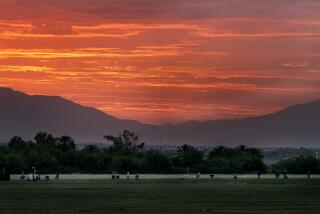Urban land expansion now at fastest rate ever
Urban land expansion in the first 30 years of this century may exceed all previous development throughout history, and will carry dire consequences for endangered species and sensitive habitat, a recent study says.
With urban areas across the globe expanding at a rate twice that of population growth, environmental scientists predicted that new development could cover an area roughly the size of South Africa by 2030. Nearly half that anticipated development would occur in Asia, with China and India making up the majority.
The study, published Monday in the science journal PNAS, used satellite imagery from NASA, United Nations’ population projections and economic forecasts to gauge future expansion of the planet’s urban footprint. This development, the authors wrote, threatened the loss of 40% of the species in some of the planet’s most biologically diverse areas and would reduce the planet’s ability to store the greenhouse gas carbon dioxide by eliminating vast tracts of vegetation.
“Cities now are developing in ways that are quite different from cities of 100 and 200 years ago,” said Karen Seto, a study author and associate professor of urban environment at the Yale School of Forestry and Environmental Studies. “Cities are growing at an incredibly fast rate. Fifty years ago we had two mega-cities of 10 million, and right now we have 19 mega-cities. In another 30 years we’re adding about another 10 more mega-cities. The rate at which these cities are developing is unprecedented.”
Urban expansion would likely encroach upon or destroy habitats for 139 amphibian species, 41 mammal species and 25 bird species that are either on the critically endangered or endangered lists of the International Union for Conservation and Nature.
In China, urban expansion is forecasted to create a 1,100-mile coastal urban corridor from Hangzhou to Shenyang, the authors wrote. In India, expansion is expected to cluster around seven state capitals.
However, the highest rate of urban cover is expected to occur in Africa, where it is expected to grow by almost 600%. High growth areas there include the Nile River in Egypt; the coast of West Africa on the Gulf of Guinea; the northern shores of Lake Victoria in Kenya and Uganda; northern Nigeria and Addis Ababa, Ethiopia.
In North America, urban land cover is expected to double by 2030.
Although urban areas comprise a very small area of the planet’s total surface area, their impact reaches far beyond urban borders, the authors wrote. Cities often look to rural areas for critical resources such as water, waste disposal and fuel. City dwellers also consume more meat and dairy products than rural residents, creating further demands.
The authors recommended that policy makers and urban designers consider these impacts in effort to guide development.
“The full environmental impacts will not be confined to urban boundaries and will largely be felt elsewhere,” the authors wrote.
monte.morin@latimes.com







